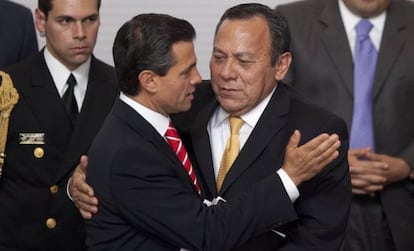Mexico breaks TV duopoly by handing out new broadcasting licenses
Two newcomer networks face tough challenges as they compete in the digital age


Breaking a long-standing duopoly since broadcasting began in Mexico, President Enrique Peña Nieto’s government on Wednesday awarded licenses for two new television networks being planned by the influential media tycoons Olegario Vázquez Raña and Francisco Aguirre.
When it was first announced last year that TV licenses would be awarded to the highest bidder, as part of Peña Nieto’s telecommunications reform, the auction had generated high expectations.
Government plans to hand out digital sets to families who cannot afford them has been criticized by the opposition
But in the end two media groups – Vázquez Raña’s Cadena Tres and Aguirre’s Grupo Centro – were the only bidders.
Mexico’s IFT telecoms regulator had set a minimum bid of $60 million for each new network. But both Grupo Centro and Cadena Tres surprised everyone by offering $194 million and $113 million, respectively, for their 20-year licenses.
Grupo Centro owns 15 radio stations while Cadena Tres is part of a smaller conglomerate that includes the Mexico City daily Excélsior.
The Mexican TV market has long been dominated by Televisa and Televisión Azteca.
There is a lack of confidence in the immediate future of Mexico’s television industry, which the telecommunications reform is expected to change.
When the bidding was announced, media conglomerates rushed to get information to take part in the auction: an estimated $4 billion in annual revenues are at hand. But the drop in global oil prices and less hope for an upturn in Mexico’s dwindling economy put a freeze on prospective bidders.
Now the two new players in the television spectrum will have to deal with long-established competitors Televisa, which has a 45-percent audience share, and Televisión Azteca, with a 20 percent viewership.
As part of the terms, the new networks will only be able to broadcast on a digital platform, which is critical because 45 percent of Mexican households still own analogue television sets and won’t be able to receive their signals.
The Mexican government plans on switching the country from analogue to digital at the end of the year
To see where they stand, the broadcasters must wait until December 31, when the government plans on switching the entire country from analogue to digital. But if that change is delayed, as some observers predict, Grupo Centro and Cadena Tres will find themselves in tough spots.
“It is not fair that we have to put down money for a market that doesn’t yet exist,” said Grupo Centro chairman Aguirre.
At the same time, the Peña Nieto government has proposed handing out digital sets to families who cannot afford them – a move that has been criticized by the opposition as a campaign ploy as Mexicans go to the polls this year in local and state elections.
It is not fair that we have to put down money for a market that doesn’t yet exist” Grupo Centro chairman Francisco Aguirre
Uncertainty in the future television market is high. Even Mexico’s telecoms regulator, the same entity that handed out the licenses, predicted that the new broadcasters will only be able to capture an 8.5-percent audience share by 2020.
“The reform was conceived with a lot challenges, including a very difficult market structure and a slow transition to digital,” said Mony de Swaan, a former chairman of the Federal Telecommunications Commission. “I believe that Cadena Tres and Grupo Centro will join forces to compete with Televisa and Televisión Azteca.
“It has taken a long time to put this reform in operation – maybe too long – but that doesn’t mean this isn’t good news. There will be more viewer options and hopefully this means there should be better quality of programming.”
Tu suscripción se está usando en otro dispositivo
¿Quieres añadir otro usuario a tu suscripción?
Si continúas leyendo en este dispositivo, no se podrá leer en el otro.
FlechaTu suscripción se está usando en otro dispositivo y solo puedes acceder a EL PAÍS desde un dispositivo a la vez.
Si quieres compartir tu cuenta, cambia tu suscripción a la modalidad Premium, así podrás añadir otro usuario. Cada uno accederá con su propia cuenta de email, lo que os permitirá personalizar vuestra experiencia en EL PAÍS.
¿Tienes una suscripción de empresa? Accede aquí para contratar más cuentas.
En el caso de no saber quién está usando tu cuenta, te recomendamos cambiar tu contraseña aquí.
Si decides continuar compartiendo tu cuenta, este mensaje se mostrará en tu dispositivo y en el de la otra persona que está usando tu cuenta de forma indefinida, afectando a tu experiencia de lectura. Puedes consultar aquí los términos y condiciones de la suscripción digital.
More information
Últimas noticias
The complicated life of Francesca Albanese: A rising figure in Italy but barred from every bank by Trump’s sanctions
From digital curfews to blocking apps: How technology experts protect their children online
Why the price of coffee has skyrocketed: from Brazilian plantations to specialty coffee houses
Confined to a Cuban hospital: When electricity is a matter of life or death
Most viewed
- Pablo Escobar’s hippos: A serious environmental problem, 40 years on
- Why we lost the habit of sleeping in two segments and how that changed our sense of time
- Trump’s obsession with putting his name on everything is unprecedented in the United States
- Charles Dubouloz, mountaineering star, retires at 36 with a farewell tour inspired by Walter Bonatti
- The Florida Keys tourist paradise is besieged by immigration agents: ‘We’ve never seen anything like this’









































